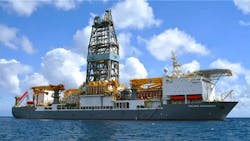CO2 in deepwater Bumerangue find offshore Brazil appears manageable, bp suggests
bp has issued more details of its potentially major discovery this August at the deepwater Bumerangue block, in the presalt Santos Basin offshore Brazil.
Well 1-BP-13-SPS was drilled 404 km offshore in a water depth of 2,372 m, reaching a total depth of 5,855 m. It intersected a reservoir containing good-quality presalt carbonate rock, over an area of more than 300 sq km.
Laboratory and pressure gradient analysis has confirmed a ~1,000-m gross hydrocarbon column, bp said, comprising a ~100-m gross oil column and a ~900-m gross liquids rich gas-condensate column.
Although the reservoir also contains CO2, this should be manageable, the company added, due to the presence of liquids throughout the full hydrocarbon column and the high-quality rock properties observed to date.
Laboratory testing continues, as does analysis to determine the fluid characteristics, the gas-to-oil and condensate-to-gas ratios, and estimation of in-place volumes.
Plans are underway for future appraisal drilling, which could start early in 2027, subject to regulatory approval.
“Initial results and analysis are extremely encouraging as they indicate a very large hydrocarbon column and a significant volume of liquids in the reservoir," said Gordon Birrell, bp’s executive vice president for Production & Operations. “We are pleased about what we have seen to date, and our confidence in the potential of this field has increased. We have a team in place and are accelerating work on proposed appraisal activities and potential development concepts, which will include the potential for an early production system.”
Bumerangue is one of 12 exploration discoveries for bp this year globally.

